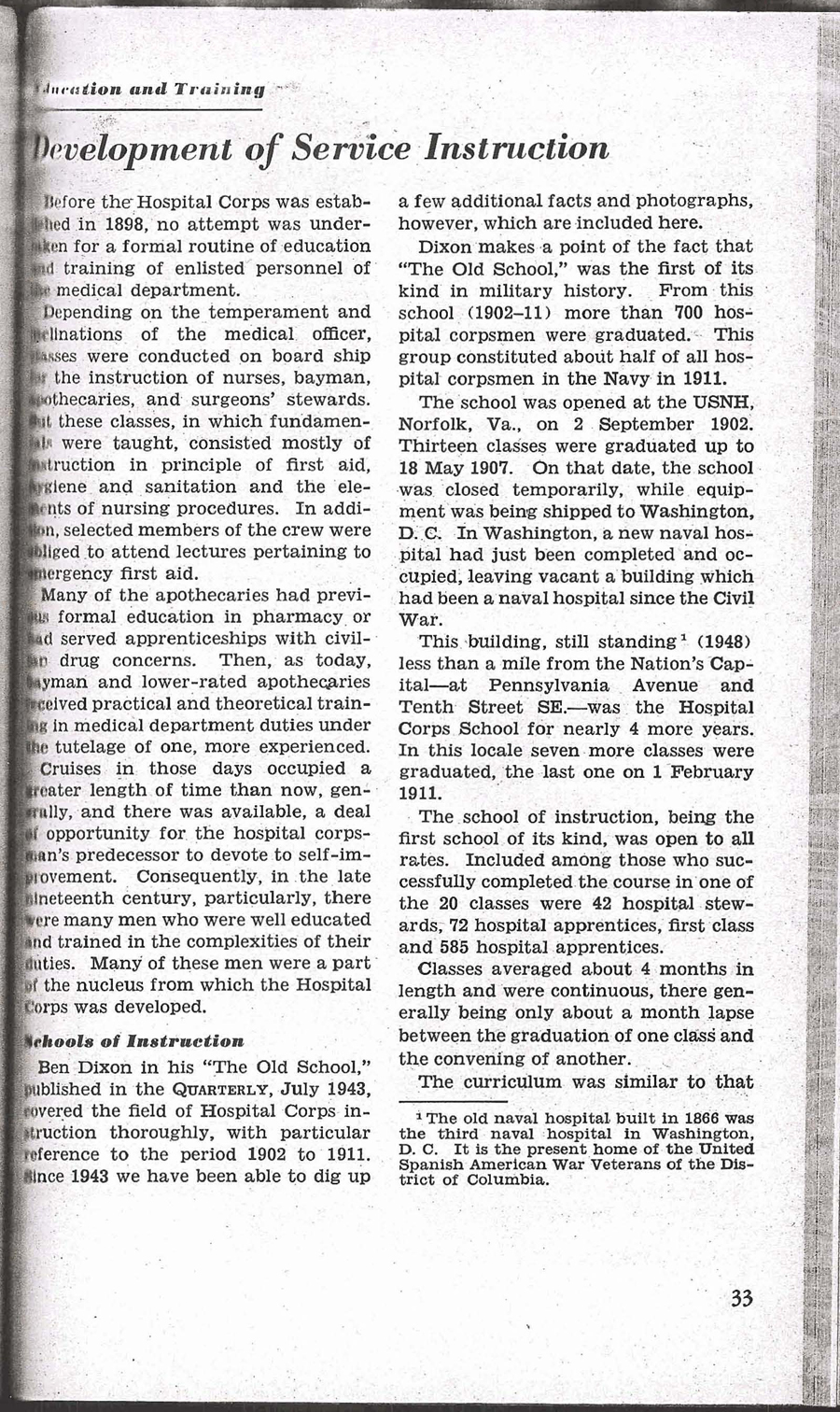

Page 33
Instruction and Training
Development of Service Instruction
Before the Hospital Corps was established in 1898, no attempt was undertaken for a formal routine of education and training of enlisted personnel of the medical department.
Depending on the temperament and inclinations of the medical officer, classes were conducted on board ship for the instruction of nurses, bayman, apothecaries, and surgeons’ stewards. But these classes, in which fundamentals were taught, consisted mostly of instruction in principle of first aid, hygiene and sanitation and the elements of nursing procedures. In addition, selected members of the crew \were obliged to attend lectures pertaining to emergency first aid.
Many of the apothecaries had previous formal education in pharmacy or had served apprenticeships with civilian drug concerns. Then, as today, bayman and lower-rated apothecaries received practical and theoretical training in medical department duties under the tutelage of one, more experience.
Cruises in those days occupied a greater length of time than now, generally, and there was available, a deal of opportunity for the hospital corpsman’s predecessor to devote to self-improvement. Consequently, in the late nineteenth century, particularly, there were many men who were well educated and trained in the complexities of their duties. Many of these men were a part of the nucleus from which the Hospital Corps was developed.
Schools of Instruction
Ben Dixon in his “The Old School,” published in the QUARTERLY, July 1943, covered the field of Hospital Corps instruction thoroughly, with particular reference to the period 1902 to 1911. Since 1943, we have been able to dig up a few additional facts and photographs, however, which are included here.
Dixon makes a point of the fact that “The Old School” was the first of its kind in military history. From this school (1902-11) more than 700 hospital corpsmen were graduated. This group constituted about half of all hospital corpsmen in the Navy in 1911.
The school was opened at the USNH, Norfolk, Va., on 2 September 1902. Thirteen classes were graduated up to 18 May 1907. On that date, the school was closed temporarily, while equipment was being shipped to Washington, D.C. In Washington, a new naval hospital had just been completed and occupied, leaving vacant a building which had been a naval hospital since the Civil War.
This building, still standing (NOTE 1) (1948) less than a mile form the Nation’s Capital – At Pennsylvania Avenue and Tenth Street SE – was the Hospital Corps School for nearly 4 more years. In this locale seven more classes were graduated, the last one on 1 February 1911.
The school of instruction, being the first school of its kind, was open to all rates. Included among those who successfully completed the course in one of the 20 classes were 42 hospital stewards, 72 hospital apprentices, first class and 585 hospital apprentices.
Classes average about 4 months in length and were continuous, there generally being only about a month lapse between the graduation of one class and the convening of another.
The curriculum was similar to that (continued on page 34)
NOTE 1 – The old naval hospital built in 1866 was the third naval hospital in Washington, D.C. It is the present home of the United Spanish American War Veterans of the District of Columbia.
This site is sponsored by the Friends of the Old Naval Hospital
Last updated November 21, 2008